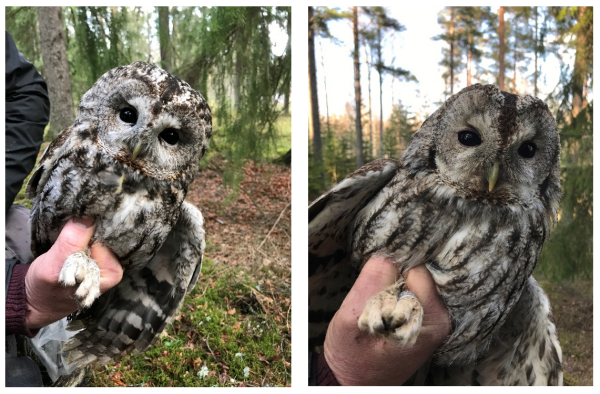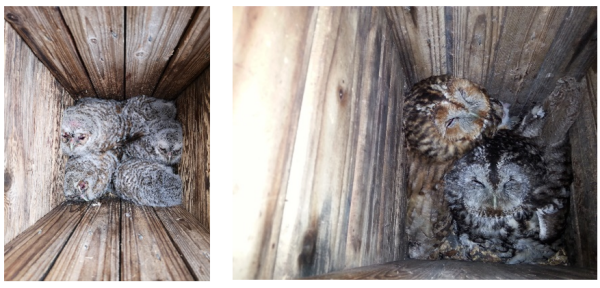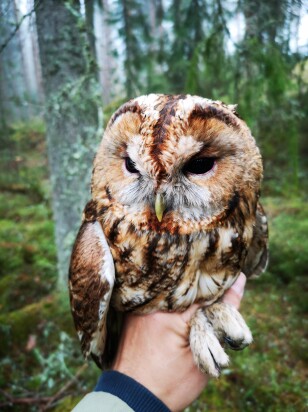Dr. Morosinotto Discusses Brown and Grey Tawny Owl Research Findings
Dr. Chiara Morosinotto is a Behavioural Ecologist and researcher based at the Novia UAS campus in Raasepori, Finland. Currently, Dr. Morosinotto studies Tawny owls (Strix aluco) as part of a project lead by Dr. Patrik Karell at Novia University of Applied Sciences.
Dr. Morosinotto has been focusing her research on habitat selection in predator-prey interactions, parental care and maternal allocation in eggs, and behavioural and physiological responses depending on perceived predation risk and food availability.
We interviewed Dr. Morosinotto to find out more about her current research which is being conducted as part of the "Spatio-temporal eco-evolutionary dynamics under environmental change" project.
Tawny Owl Research
Could you tell a little more about Tawny owls and why they are an interesting research topic?
Tawny owls have a genetically based colour polymorphism which means that there are two distinct colourations, the grey and the brown, which depends on the level of melanin that they have in the feathers. Whether an individual owl will be grey or brown is highly heritable from the parents and it is associated with physiological and behavioural traits which are specific of that morph.
A very interesting study by Dr. Patrik Karell, conducted in 2011, showed that the survival of these two morphs is strongly affected by the winter temperature and the snow cover. Karell discovered that the grey owls manage to survive quite well even if it is very cold and snowy, whereas the brown owls have a much lower survival rate in those same conditions.
However, in the years when the winter conditions are milder, the brown owls survive equally as well. Although, this does not mean that the brown tawny owls have an advantage during milder winters, they just survive equally as well as the grey owls.
Findings
Why is this finding significant?
Across the past 100 years or so we have been able to see an increment in the numbers of brown owls because the temperatures have become milder and thus survival of brown owls improves. This is a textbook example that shows how climate change is related to the survival of an animal linked to differences in phenotypic traits.
Dr. Patrik Karell built upon this paper and did further research to try and better understand the physiology and behaviour of these two morphs. He wanted to have them as an example of how different genotypes interact with their environment and what happens when we change that environment.
Are there any other findings which you consider to be especially significant?
Yes, there are three other papers with significant findings.
The first paper studied the condition of Tawny owl offspring when they leave the nest and their probability to return to the population in the future. This research discovered that the brown owl offspring were on average heavier than the grey ones.
This was important for the research team to know since the first few months are the most dangerous for the owlets and heavier owlets survive better during this period. They also discovered that probability to return was not linked to whether the owlets were brown or grey but, instead, to their overall condition. Healthier owls were more likely to return, and this was especially so in the years were winters were mild.
The second paper, lead by Dr. Arianna Passarotto, postdoc researcher in Dr. Karell’s group, studied the ways in which these two morphs choose their territories. During this research, it was determined that the distance of the owls’ new territory, from their birth one, is dependent on both the owls’ colouring and the temperature during the winter that they moved away.
The brown owl stays closer during cold winters and moves further during warmer winters whilst the grey owl can move further away in cold winter temperatures.
The third paper, lead by Dr. Karell, used 40 years of research on nest material to determine that the owls also have different diets. The grey owl seems to be very specific in eating mostly small mammals. Whereas the brown owl appears to be more of a generalist in its diet, eating small mammals but also birds and other species.
Why are these findings important?
These findings allow researchers to study how animals with different genotypes cope with the environment and with how the environment is changing and how they adapt. Especially now, with global changes in environment and climate change, it may allow researchers to predict what may happen in the future.
Dr. Karell’s research regarding the eating habits of Tawny owls is relevant because, at an ecosystem level, it means that there may also be some differences depending on whether there are brown or grey owls in the forest.
To date, we have seen that brown owls are increasing in the forests within Finland and in Europe. This means that these dietary differences between the two morphs might have quite significant ecological consequences in the long run.
Research Visit
You are currently on a research visit at Lund University, in Sweden. What will you be doing during your visit?
I am here to organise and analyse the data we collected on 1) owl metabolic differences and 2) owl differences on telomere length and life history strategies.
How are these two sets of data connected with the research you have been doing as part of the “Spatio-temporal eco-evolutionary dynamics under environmental change” project at Novia UAS?
The first data set is from an experiment conducted at Lund University in late 2020 and late 2021 (November-December). This research is linked to Dr. Karell's paper from 2011 which showed that brown owls survive less well in harsh winter conditions.
It has been suggested that this difference in survival during winter could be linked to different physiological traits among the morphs, but it has never been studied before.
To understand the physiological mechanisms driving this difference in survival under harsh winter conditions, we studied differences in owl metabolism under a gradient of experimentally manipulated cold temperatures.
The second dataset I'm analysing concerns telomere dynamics among morphs. Telomeres are small "caps" that are present at the ends of the chromosome which protect the DNA from damage.
Telomeres, because of their function, are renown markers of aging and body conditions. In other words, the older the animal or human is the shorter the telomeres. Additionally, when health issues, such as parasitic infections and stress, are present the telomeres shorten.
Dr. Karell’s research in 2017 shows that grey and brown owls differ in their telomere dynamics when they are adults. Brown adults have much shorter telomeres than grey ones and the brown adults also have faster telomere shortening.
However, one of my recent papers from 2021 showed that this is only the case for adults, not for small owlets, as offspring don't have differences in their telomeres.
This means that the different length of the telomeres is probably as a result of the different life history strategies adopted by the adults of the two morphs.
Currently, one of my research papers (under review) shows that telomere lengths are highly heritable from the parents and that offspring of older fathers have shorter telomeres.
Have there been any significant or interesting findings so far?
I'm now here in Lund to build on these three papers combined and to study if telomere length is a predictor of lifetime reproductive success, in other words, of the total number of offspring an individual can have in its life.
Lifetime reproductive success is an important measure of fitness and, since previous studies shows that morphs differ in telomere dynamics, we can expect it is associated to telomere length and will be different between the morphs.
So far, I have found that there is indeed a difference in the association between telomere length and lifetime reproductive success in the two morphs, both of which seem to adopt different strategies.
The grey individuals seem to invest more in survival whilst the brown individuals seem to invest more in reproduction.
When can we expect to hear more about the data you are analysing during your research visit?
From my visit in Lund, I should be able to finalise the analyses of both experiments and then hopefully we will have many new and interesting results to present.
Further Information
For more information about the above research, please follow the project on Twitter at @ECCHO_owl
If you would like to know more, please contact
Researcher
Patrik Karell
Patrik.Karell@novia.fi
+358444498415
Brown Tawny Owl Being Held by Researcher
(Photo Provided by Chiara Morosinotto)
 Tawny Owls Being Held by Researcher (Photo Provided by Chiara Morosinotto)
Tawny Owls Being Held by Researcher (Photo Provided by Chiara Morosinotto) Tawny Owls and Owlets in Their Nests (Photo Provided by Chiara Morosinotto)
Tawny Owls and Owlets in Their Nests (Photo Provided by Chiara Morosinotto)

